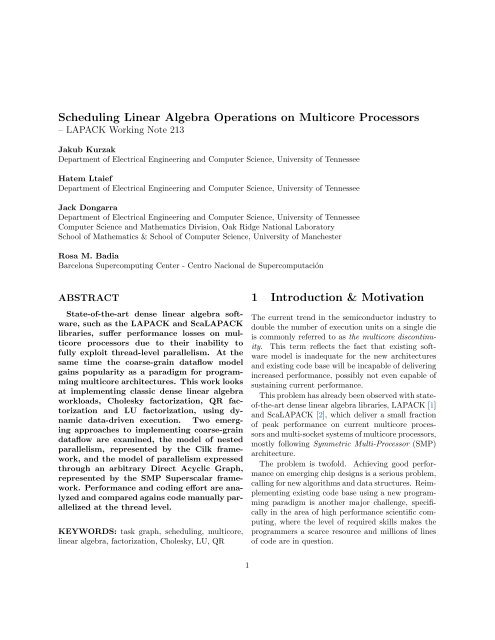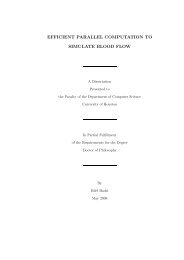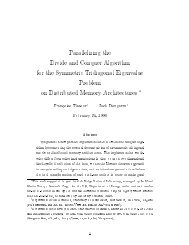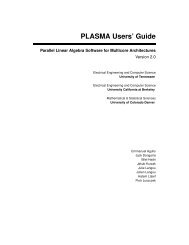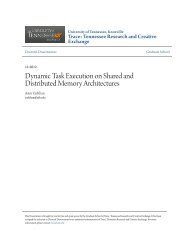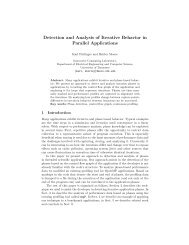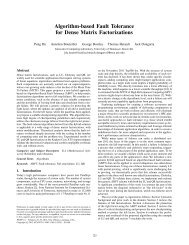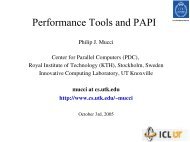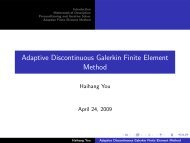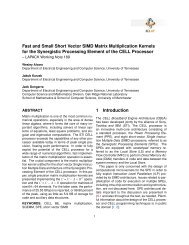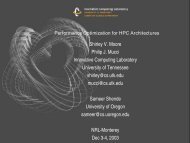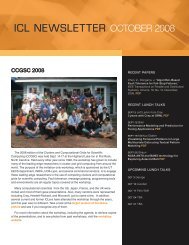Scheduling Linear Algebra Operations on Multicore ... - Netlib
Scheduling Linear Algebra Operations on Multicore ... - Netlib
Scheduling Linear Algebra Operations on Multicore ... - Netlib
You also want an ePaper? Increase the reach of your titles
YUMPU automatically turns print PDFs into web optimized ePapers that Google loves.
<str<strong>on</strong>g>Scheduling</str<strong>on</strong>g> <str<strong>on</strong>g>Linear</str<strong>on</strong>g> <str<strong>on</strong>g>Algebra</str<strong>on</strong>g> <str<strong>on</strong>g>Operati<strong>on</strong>s</str<strong>on</strong>g> <strong>on</strong> <strong>Multicore</strong> Processors<br />
– LAPACK Working Note 213<br />
Jakub Kurzak<br />
Department of Electrical Engineering and Computer Science, University of Tennessee<br />
Hatem Ltaief<br />
Department of Electrical Engineering and Computer Science, University of Tennessee<br />
Jack D<strong>on</strong>garra<br />
Department of Electrical Engineering and Computer Science, University of Tennessee<br />
Computer Science and Mathematics Divisi<strong>on</strong>, Oak Ridge Nati<strong>on</strong>al Laboratory<br />
School of Mathematics & School of Computer Science, University of Manchester<br />
Rosa M. Badia<br />
Barcel<strong>on</strong>a Supercomputing Center - Centro Naci<strong>on</strong>al de Supercomputación<br />
ABSTRACT<br />
State-of-the-art dense linear algebra software,<br />
such as the LAPACK and ScaLAPACK<br />
libraries, suffer performance losses <strong>on</strong> multicore<br />
processors due to their inability to<br />
fully exploit thread-level parallelism. At the<br />
same time the coarse-grain dataflow model<br />
gains popularity as a paradigm for programming<br />
multicore architectures. This work looks<br />
at implementing classic dense linear algebra<br />
workloads, Cholesky factorizati<strong>on</strong>, QR factorizati<strong>on</strong><br />
and LU factorizati<strong>on</strong>, using dynamic<br />
data-driven executi<strong>on</strong>. Two emerging<br />
approaches to implementing coarse-grain<br />
dataflow are examined, the model of nested<br />
parallelism, represented by the Cilk framework,<br />
and the model of parallelism expressed<br />
through an arbitrary Direct Acyclic Graph,<br />
represented by the SMP Superscalar framework.<br />
Performance and coding effort are analyzed<br />
and compared agains code manually parallelized<br />
at the thread level.<br />
KEYWORDS: task graph, scheduling, multicore,<br />
linear algebra, factorizati<strong>on</strong>, Cholesky, LU, QR<br />
1 Introducti<strong>on</strong> & Motivati<strong>on</strong><br />
The current trend in the semic<strong>on</strong>ductor industry to<br />
double the number of executi<strong>on</strong> units <strong>on</strong> a single die<br />
is comm<strong>on</strong>ly referred to as the multicore disc<strong>on</strong>tinuity.<br />
This term reflects the fact that existing software<br />
model is inadequate for the new architectures<br />
and existing code base will be incapable of delivering<br />
increased performance, possibly not even capable of<br />
sustaining current performance.<br />
This problem has already been observed with stateof-the-art<br />
dense linear algebra libraries, LAPACK [1]<br />
and ScaLAPACK [2], which deliver a small fracti<strong>on</strong><br />
of peak performance <strong>on</strong> current multicore processors<br />
and multi-socket systems of multicore processors,<br />
mostly following Symmetric Multi-Processor (SMP)<br />
architecture.<br />
The problem is twofold. Achieving good performance<br />
<strong>on</strong> emerging chip designs is a serious problem,<br />
calling for new algorithms and data structures. Reimplementing<br />
existing code base using a new programming<br />
paradigm is another major challenge, specifically<br />
in the area of high performance scientific computing,<br />
where the level of required skills makes the<br />
programmers a scarce resource and milli<strong>on</strong>s of lines<br />
of code are in questi<strong>on</strong>.<br />
1
2 Background<br />
In large scale scientific computing, targeting distributed<br />
memory systems, the recent push towards<br />
the PetaFlop barrier caused a renewed interest in<br />
Partiti<strong>on</strong>ed Global Address Space (PGAS) languages,<br />
such as Co-Array Fortran (CAF) [3], Unified Parallel<br />
C (UPC) [4] or Titanium [5], as well as emergence<br />
of new languages, such as Chapel (Cray) [6],<br />
Fortress (Sun) [7] and X-10 (IBM) [8], sp<strong>on</strong>sored<br />
through the DARPA’s High Productivity Computing<br />
Systems (HPCS) program.<br />
In more mainstream, server and desktop computing,<br />
targeting mainly shared memory systems,<br />
the well known dataflow model is rapidly gaining<br />
popularity, where the computati<strong>on</strong> is viewed<br />
as a Direct Acyclic Graph (DAG), with nodes<br />
representing computati<strong>on</strong>al tasks and edges representing<br />
data dependencies am<strong>on</strong>g them. The<br />
coarse-grain dataflow model is the main principle behind<br />
emerging multicore programming envir<strong>on</strong>ments<br />
such as Cilk/Cilk++ [9], Intel R○ Threading Building<br />
Blocks (TBB) [10, 11], Tasking in OpenMP 3.0 [12,<br />
13, 14, 15] and SMP Superscalar (SMPSs) [16].<br />
All these frameworks rely <strong>on</strong> a very small set of<br />
extensi<strong>on</strong>s to comm<strong>on</strong> imperative programming languages<br />
such as C/C++ and Fortran and involve a<br />
relatively simple compilati<strong>on</strong> stage and potentially<br />
much more complex runtime system.<br />
The following secti<strong>on</strong>s provide a brief overview<br />
of these frameworks, as well as an overview of a<br />
rudimentary scheduler implemented using POSIX<br />
threads, which will serve as a baseline for performance<br />
comparis<strong>on</strong>s.<br />
Since tasking facilities available in Threading<br />
Building Blocks and OpenMP 3.0 closely resemble<br />
the <strong>on</strong>es provided by Cilk, Cilk is chosen as a<br />
representative framework for all three (also due to<br />
the reas<strong>on</strong> that, same as SMPSs, it is available in<br />
open-source).<br />
2.1 Cilk<br />
Cilk was developed at the MIT Laboratory for Computer<br />
Science starting in 1994 [9]. Cilk is an extensi<strong>on</strong><br />
of the C language with a handful of keywords<br />
(cilk, spawn, sync, inlet, abort) aimed at providing<br />
general-purpose programming language designed for<br />
multithreaded parallel programming. When the Cilk<br />
keywords are removed from Cilk source code, the result<br />
is a valid C program, called the serial elisi<strong>on</strong> (or<br />
C elisi<strong>on</strong>) of the full Cilk program. The Cilk envir<strong>on</strong>ment<br />
employs a source-to-source compiler, which<br />
compiles Cilk code to C code, a standard C compiler,<br />
and a runtime system linked with the object code to<br />
provide an executable.<br />
The main principle of Cilk is that the programmer<br />
is resp<strong>on</strong>sible for exposing parallelism by identifying<br />
functi<strong>on</strong>s free of side effects (e.g., access to<br />
global variables causing race c<strong>on</strong>diti<strong>on</strong>s), which can<br />
be treated as independent tasks and executed in parallel.<br />
Such functi<strong>on</strong>s are annotated with the cilk<br />
keyword and invoked with the spawn keyword. The<br />
sync keyword is used to indicate that executi<strong>on</strong> of<br />
the current procedure cannot proceed until all previously<br />
spawned procedures have completed and returned<br />
their results to the parent.<br />
Distributi<strong>on</strong> of work to multiple processors is handled<br />
by the runtime system. Cilk scheduler uses the<br />
policy called work-stealing to schedule executi<strong>on</strong> of<br />
tasks to multiple processors. At run time, each processor<br />
fetches tasks from the top of its own stack - in<br />
First In First Out (FIFO) order. However, when a<br />
processor runs out of tasks, it picks another processor<br />
at random and ”steals” tasks from the bottom of<br />
its stack - in Last In First Out (LIFO) order. This<br />
way the task graph is c<strong>on</strong>sumed in a depth-first order,<br />
until a processor runs out of tasks, in which case<br />
it steals tasks from other processors in a breadth-first<br />
order.<br />
Cilk also provides the mechanism of locks. The<br />
use of lock can, however, easily lead to deadlock.<br />
”Even if the user can guarantee that his program is<br />
deadlock-free, Cilk may still deadlock <strong>on</strong> the user’s<br />
code because of some additi<strong>on</strong>al scheduling c<strong>on</strong>straints<br />
imposed by Cilk’s scheduler” [17]. In particular<br />
locks cannot be used to enforce parent-child<br />
dependencies between tasks.<br />
Cilk is very well suited for expressing algorithms<br />
which easily render themselves to recursive formulati<strong>on</strong>,<br />
e.g., divide-and-c<strong>on</strong>quer algorithms. Since stack<br />
is the main structure for c<strong>on</strong>trolling parallelism, the<br />
2
model allows for straightforward implementati<strong>on</strong>s <strong>on</strong><br />
shared memory multiprocessor systems (e.g., multicore/SMP<br />
systems). The simplicity of the model provides<br />
for executi<strong>on</strong> of parallel code with virtually no<br />
overhead from scheduling.<br />
2.2 OpenMP<br />
OpenMP was born in the ’90s to bring a standard<br />
to the different directive languages defined by several<br />
vendors. The different characteristics of this approach:<br />
simplicity of the interface, use of a shared<br />
memory model, and the use of loosely-coupled directives<br />
to express the parallelism of a program, make<br />
it very well-accepted today. Due to new needs of the<br />
parallel applicati<strong>on</strong>s, OpenMP has been recently extended<br />
to add, in its versi<strong>on</strong> 3.0, a tasking model that<br />
addresses new programming model aspects.<br />
The new OpenMP directives allows the programmer<br />
to identify units of independent work (tasks),<br />
leaving the decisi<strong>on</strong> to how and when to execute them<br />
to the runtime system.<br />
This gives the programmers a way of expressing<br />
patterns of c<strong>on</strong>currency that do not match the worksharing<br />
c<strong>on</strong>structs defined in the OpenMP 2.5 specificati<strong>on</strong>.<br />
The main difference between Cilk and<br />
OpenMP 3.0 is that the latter can combine both types<br />
of parallelism, worksharing and tasks: for example,<br />
a programmer can choose to use OpenMP tasks to<br />
exploit the parallelism of an inner loop and the traditi<strong>on</strong>al<br />
worksharing c<strong>on</strong>struct to parallelize an outer<br />
loop.<br />
2.3 Intel R○ Threading Building Blocks<br />
Intel R○Threading Building Blocks is a runtime-based<br />
parallel programming model for C++ code that uses<br />
threads. The main difference with other threading<br />
packages is that it enables the programmer to specify<br />
tasks instead of threads and the runtime library<br />
automatically schedules tasks <strong>on</strong>to threads in a way<br />
that makes efficient use of a multicore processor.<br />
Another characteristic of TBB is that it focuses<br />
<strong>on</strong> the particular goal of parallelizing computati<strong>on</strong>ally<br />
intensive work, while this is not always true in<br />
general-purpose threading packages. TBB emphasizes<br />
data-parallel programming, enabling multiple<br />
threads to work <strong>on</strong> different parts of a collecti<strong>on</strong> enabling<br />
scalability to larger number of cores.<br />
The programming model is based <strong>on</strong> template<br />
functi<strong>on</strong>s (parallel for, parallel reduce, etc.), where<br />
the user specifies the range of data to be accessed,<br />
how to partiti<strong>on</strong> the data, the task to be executed in<br />
each chunk.<br />
2.4 SMPSs<br />
SMP Superscalar (SMPSs) [16] is a parallel programming<br />
framework developed at the Barcel<strong>on</strong>a<br />
Supercomputer Center (Centro Naci<strong>on</strong>al de Supercomputación),<br />
part of the STAR Superscalar family,<br />
which also includes Grid Supercalar and Cell Superscalar<br />
[18, 19]. While Grid Superscalar and Cell Superscalar<br />
address parallel software development for<br />
Grid enviroments and the Cell processor respectively,<br />
SMP Superscalar is aimed at ”standard” (x86 and<br />
like) multicore processors and symmetric multiprocessor<br />
systems.<br />
The principles of SMP Superscalar are similar to<br />
the <strong>on</strong>es of Cilk. Similarly to Cilk, the programmer is<br />
resp<strong>on</strong>sible for identifying parallel tasks, which have<br />
to be side-effect-free (atomic) functi<strong>on</strong>s. Additi<strong>on</strong>ally,<br />
the programmer needs to specify the directi<strong>on</strong>ality<br />
of each parameter (input, output, inout). If the<br />
size of a parameter is missing in the C declarati<strong>on</strong><br />
(e.g., the parameter is passed by pointer), the programmer<br />
also needs to specify the size of the memory<br />
regi<strong>on</strong> affected by the functi<strong>on</strong>. Unlike Cilk, however,<br />
the programmer is not resp<strong>on</strong>sible for exposing the<br />
structure of the task graph. The task graph is built<br />
automatically, based <strong>on</strong> the informati<strong>on</strong> of task parameters<br />
and their directi<strong>on</strong>ality.<br />
Similarly to Cilk, the programming envir<strong>on</strong>ment<br />
c<strong>on</strong>sists of a source-to-source compiler and a supporting<br />
runtime library. The compiler translates C code<br />
with pragma annotati<strong>on</strong>s to standard C99 code with<br />
calls to the supporting runtime library and compiles<br />
it using the platform native compiler.<br />
At runtime the main thread creates worker threads,<br />
as many as necessary to fully utilize the system, and<br />
starts c<strong>on</strong>structing the task graph (populating its<br />
3
eady list). Each worker thread maintains its own<br />
ready list and populates it while executing tasks. A<br />
thread c<strong>on</strong>sumes tasks from its own ready list in<br />
LIFO order. If that list is empty, the thread c<strong>on</strong>sumes<br />
tasks from the main ready list in FIFO order,<br />
and if that list is empty, the thread steals tasks from<br />
the ready lists of other threads in FIFO order.<br />
The SMPSs scheduler attempts to exploit locality<br />
by scheduling dependent tasks to the same thread,<br />
such that output data is reused immediately. Also, in<br />
order to reduce dependencies, SMPSs runtime is capable<br />
of renaming data, leaving <strong>on</strong>ly the true dependencies,<br />
which is the same technique used by superscalar<br />
processors [20] and optimizing compilers [21].<br />
The main difference between Cilk and SMPSs is<br />
that, while the former allows mainly for expressi<strong>on</strong><br />
of nested parallelism, the latter handles computati<strong>on</strong><br />
expressed as an arbitrary DAG. Also, while Cilk requires<br />
the programmer to create the DAG by means<br />
of the spawn keyword, SMPSs creates the DAG automatically.<br />
C<strong>on</strong>structi<strong>on</strong> of the DAG does, however,<br />
introduce overhead, which is virtually inexistent in<br />
the Cilk envir<strong>on</strong>ment.<br />
2.5 Static Pipeline<br />
The static pipeline scheduling presented here was<br />
originally implemented for dense matrix factorizati<strong>on</strong>s<br />
<strong>on</strong> the CELL processor [22, 23]. This technique<br />
is extremely simple and yet provides good locality of<br />
reference and load balance for regular computati<strong>on</strong>,<br />
like dense matrix operati<strong>on</strong>s.<br />
In this approach each task is uniquely identified by<br />
the {m, n, k} triple, which determines the type of operati<strong>on</strong><br />
and the locati<strong>on</strong> of tiles operated up<strong>on</strong>. Each<br />
core traverses its task space by applying a simple formula<br />
to the {m, n, k} triple, which takes into account<br />
the id of the core and the total number of cores in the<br />
system.<br />
Task dependencies are tracked by a global progress<br />
table, where <strong>on</strong>e element describes progress of computati<strong>on</strong><br />
for <strong>on</strong>e tile of the input matrix. Each core<br />
looks up the table before executing each task to check<br />
for dependencies and stalls if dependencies are not<br />
satisfied. Each core updates the progress table after<br />
completi<strong>on</strong> of each task. Access to the table does not<br />
require mutual exclusi<strong>on</strong> (using, e.g., mutexes). The<br />
table is declared as volatile. Update is implemented<br />
by writing to an element. Dependency stall is implemented<br />
by busy-waiting <strong>on</strong> an element.<br />
The use of a global progress table is a potential<br />
scalability bottleneck. It does not pose a problem,<br />
however, <strong>on</strong> small-scale multicore/SMP systems for<br />
small to medium matrix sizes. Many alternatives are<br />
possible. (Replicated progress tables were used <strong>on</strong><br />
the CELL processor [22, 23]).<br />
As further discussed in secti<strong>on</strong>s 4.3 and 5.3, this<br />
technique allows for pipelined executi<strong>on</strong> of factorizati<strong>on</strong>s<br />
steps, which provides similar benefits to dynamic<br />
scheduling, namely, executi<strong>on</strong> of the inefficient<br />
Level 2 BLAS operati<strong>on</strong>s in parallel with the efficient<br />
Level 3 BLAS operati<strong>on</strong>s.<br />
The main disadvantage of the technique is potentially<br />
suboptimal scheduling, i.e., stalling in situati<strong>on</strong>s<br />
where work is available. Another obvious weakness<br />
of the static schedule is that it cannot accommodate<br />
dynamic operati<strong>on</strong>s, e.g., divide-and-c<strong>on</strong>quer<br />
algorithms.<br />
3 Related Work<br />
Dynamic data-driven scheduling is an old c<strong>on</strong>cept<br />
and has been applied to dense linear operati<strong>on</strong>s for<br />
decades <strong>on</strong> various hardware systems. The earliest<br />
reference, that the authors are aware of, is the paper<br />
by Lord, Kowalik and Kumar [24]. A little later dynamic<br />
scheduling of LU and Cholesky factorizati<strong>on</strong>s<br />
were reported by Agarwal and Gustavs<strong>on</strong> [25, 26]<br />
Throughout the years dynamic scheduling of dense<br />
linear algebra operati<strong>on</strong>s has been used in numerous<br />
vendor library implementati<strong>on</strong>s such as ESSL,<br />
MKL and ACML (numerous references are available<br />
<strong>on</strong> the Web). In recent years the authors of<br />
this work have been investigating these ideas within<br />
the framework Parallel <str<strong>on</strong>g>Linear</str<strong>on</strong>g> <str<strong>on</strong>g>Algebra</str<strong>on</strong>g> for <strong>Multicore</strong><br />
Architectures (PLASMA) at the University of Tennessee<br />
[27, 28, 29, 30]. Noteworthy is the implementati<strong>on</strong><br />
of sparse Cholesky factorizati<strong>on</strong> by Ir<strong>on</strong>y et al.<br />
using Cilk [31].<br />
Seminal work leading to the tile QR algorithm<br />
presented here was d<strong>on</strong>e by Elmroth et al. [32,<br />
4
33, 34]. Gunter et al. presented an ”out-of-core”<br />
(out-of-memory) implementati<strong>on</strong> [35], Buttari et al.<br />
an implementati<strong>on</strong> for ”standard” (x86 and alike)<br />
multicore processors [27, 28], and Kurzak et al.<br />
an implementati<strong>on</strong> for the CELL processor [22].<br />
The LU algorithm used here was originally devised<br />
by Quintana-Ortí et al. for ”out-of-core”<br />
(out-of-memory) executi<strong>on</strong> [45].<br />
Seminal work <strong>on</strong> performance-oriented data layouts<br />
for dense linear algebra was d<strong>on</strong>e by Gustavs<strong>on</strong><br />
et al. [36, 37] and Elmroth et al. [38] and was also<br />
investigated by Park et al. [39, 40].<br />
of Cilk implementati<strong>on</strong>s, which favor the most aggressive<br />
right-looking variant.<br />
The tile Cholesky algorithm is identical to the<br />
block Cholesky algorithm implemented in LAPACK,<br />
except for processing the matrix by tiles. Otherwise,<br />
the exact same operati<strong>on</strong>s are applied. The algorithm<br />
relies <strong>on</strong> four basic operati<strong>on</strong>s implemented by four<br />
computati<strong>on</strong>al kernels (Figure 1).<br />
DSYRK<br />
DSYRK<br />
DPOTRF<br />
A T T<br />
4 Cholesky Factorizati<strong>on</strong><br />
The Cholesky factorizati<strong>on</strong> (or Cholesky decompositi<strong>on</strong>)<br />
is mainly used for the numerical soluti<strong>on</strong> of<br />
linear equati<strong>on</strong>s Ax = b, where A is symmetric and<br />
positive definite. Such systems arise often in physics<br />
applicati<strong>on</strong>s, where A is positive definite due to the<br />
nature of the modeled physical phenomen<strong>on</strong>. This<br />
happens frequently in numerical soluti<strong>on</strong>s of partial<br />
differential equati<strong>on</strong>s.<br />
The Cholesky factorizati<strong>on</strong> of an n × n real symmetric<br />
positive definite matrix A has the form<br />
DGEMM<br />
DGEMM<br />
DGEMM DTRSM<br />
A<br />
T<br />
B C C<br />
DGEMM DTRSM<br />
A = LL T ,<br />
where L is an n × n real lower triangular matrix<br />
with positive diag<strong>on</strong>al elements. In LAPACK the<br />
double precisi<strong>on</strong> algorithm is implemented by the<br />
DPOTRF routine. A single step of the algorithm is<br />
implemented by a sequence of calls to the LAPACK<br />
and BLAS routines: DSYRK, DPOTF2, DGEMM,<br />
DTRSM. Due to the symmetry, the matrix can be<br />
factorized either as upper triangular matrix or as<br />
lower triangular matrix. Here the lower triangular<br />
case is c<strong>on</strong>sidered.<br />
The algorithm can be expressed using either the<br />
top-looking versi<strong>on</strong>, the left-looking versi<strong>on</strong> of the<br />
right-looking versi<strong>on</strong>, the first being the most lazy algorithm<br />
(depth-first explorati<strong>on</strong> of the task graph)<br />
and the last being the most aggressive algorithm<br />
(breadth-first explorati<strong>on</strong> of the task graph). The<br />
left-looking variant is used here, with the excepti<strong>on</strong><br />
Figure 1: Tile operati<strong>on</strong>s in the tile Cholesky factorizati<strong>on</strong>.<br />
DSYRK: The kernel applies updates to a diag<strong>on</strong>al<br />
(lower triangular) tile T of the input matrix, resulting<br />
from factorizati<strong>on</strong> of the tiles A to the<br />
left of it. The operati<strong>on</strong> is a symmetric rank-k<br />
update.<br />
DPOTRF: The kernel performance the Cholesky<br />
factorizati<strong>on</strong> of a diag<strong>on</strong>al (lower triangular) tile<br />
T of the input matrix and overrides it with the<br />
final elements of the output matrix.<br />
DGEMM: The operati<strong>on</strong> applies updates to an<br />
off-diag<strong>on</strong>al tile C of the input matrix, resulting<br />
from factorizati<strong>on</strong> of the tiles to the left of<br />
it. The operati<strong>on</strong> is a matrix multiplicati<strong>on</strong>.<br />
5
DTRSM: The operati<strong>on</strong> applies an update to an<br />
off-diag<strong>on</strong>al tile C of the input matrix, resulting<br />
from factorizati<strong>on</strong> of the diag<strong>on</strong>al tile above it<br />
and overrides it with the final elements of the<br />
output matrix. The operati<strong>on</strong> is a triangular<br />
solve.<br />
Figure 2 shows the pseudocode of the left-looking<br />
Cholesky factorizati<strong>on</strong>. Figure 3 shows the task<br />
graph of the tile Cholesky factorizati<strong>on</strong> of a 5 × 5<br />
tiles matrix. Although the code is as simple as four<br />
loops with three levels of nesting, the task graph is<br />
far from intuitive, even for a tiny size.<br />
DPOTRF<br />
DTRSM<br />
DSYRK<br />
DTRSM DTRSM DTRSM<br />
DGEMM<br />
DGEMM DGEMM DPOTRF<br />
DGEMM DGEMM DGEMM<br />
DSYRK DSYRK DTRSM<br />
DSYRK<br />
DTRSM DTRSM<br />
DSYRK DGEMM DGEMM DGEMM<br />
DSYRK DSYRK<br />
DPOTRF<br />
DTRSM<br />
DTRSM<br />
FOR k = 0..TILES-1<br />
FOR n = 0..k-1<br />
A[k][k] ← DSYRK(A[k][n], A[k][k])<br />
A[k][k] ← DPOTRF(A[k][k])<br />
FOR m = k+1..TILES-1<br />
FOR n = 0..k-1<br />
A[m][k] ← DGEMM(A[k][n], A[m][n], A[m][k])<br />
A[m][k] ← DTRSM(A[k][k], A[m][k])<br />
DSYRK<br />
DPOTRF<br />
DGEMM DSYRK<br />
DTRSM<br />
DSYRK<br />
DPOTRF<br />
Figure 2: Pseudocode of the tile Cholesky factorizati<strong>on</strong><br />
(left-looking versi<strong>on</strong>).<br />
4.1 Cilk Implementati<strong>on</strong><br />
Figure 4 presents implementati<strong>on</strong> of Cholesky factorizati<strong>on</strong><br />
in Cilk. The basic building blocks are the<br />
functi<strong>on</strong>s performing the tile operati<strong>on</strong>s. dsyrk(),<br />
dtrsm() and dgemm() are implemented by calls to<br />
a single BLAS routine. dpotrf() is implemented by<br />
a call to the LAPACK DPOTRF routine. The functi<strong>on</strong>s<br />
are declared using the cilk keyword and then<br />
invoked using the spawn keyword.<br />
The input matrix is stored using the format referred<br />
to in literature as Square Block (SB) format<br />
or Block Data Layout (BDL). The latter name will<br />
be used here. In this arrangement, each functi<strong>on</strong> parameter<br />
is a pointer to a c<strong>on</strong>tinuous block of memory,<br />
what greatly increases cache performance and<br />
virtually eliminates cache c<strong>on</strong>flicts between different<br />
operati<strong>on</strong>s.<br />
Figure 3: Task graph of the tile Cholesky factorizati<strong>on</strong><br />
(5 × 5 tiles).<br />
For implementati<strong>on</strong> in Cilk the right-looking variant<br />
was chosen, where factorizati<strong>on</strong> of each panel is<br />
followed by an update to all the remaining submatrix.<br />
The code <strong>on</strong> Figure 4 presents a versi<strong>on</strong>, referred here<br />
as Cilk 2D, where task scheduling is not c<strong>on</strong>strained<br />
by data reuse c<strong>on</strong>siderati<strong>on</strong>s (There are no provisi<strong>on</strong>s<br />
for reuse of data between different tasks).<br />
Each step of the factorizati<strong>on</strong> involves:<br />
• factorizati<strong>on</strong> of the diag<strong>on</strong>al tile - spawning of<br />
the dpotrf() task followed by a sync,<br />
• applying triangular solves to the tiles below the<br />
diag<strong>on</strong>al tile - spawning of the dtrsm() tasks in<br />
parallel followed by a sync,<br />
• updating the tiles to the right of the panel -<br />
spawning of the dsyrk() and dgemm() tasks in<br />
parallel followed by a sync.<br />
6
cilk void dsyrk(double *A, double *T);<br />
cilk void dpotrf(double *T);<br />
cilk void dgemm(double *A, double *B, double *C);<br />
cilk void dtrsm(double *T, double *C);<br />
for (k = 0; k < TILES; k++) {<br />
spawn dpotrf(A[k][k]);<br />
sync;<br />
for (m = k+1; m < TILES; m++)<br />
spawn dtrsm(A[k][k], A[m][k]);<br />
sync;<br />
for (m = k+1; m < TILES; m++) {<br />
for (n = k+1; n < m; n++)<br />
spawn dgemm(A[k][n], A[m][n], A[m][k]);<br />
spawn dsyrk(A[k][n], A[k][k]);<br />
}<br />
sync;<br />
}<br />
code synchr<strong>on</strong>izes at each step, but panels are always<br />
overlapped with updates. This approach implements<br />
<strong>on</strong>e-level lookahead (lookahead of depth <strong>on</strong>e). Imvoid<br />
dsyrk(double *A, double *T);<br />
void dpotrf(double *T);<br />
void dgemm(double *A, double *B, double *C);<br />
void dtrsm(double *T, double *C);<br />
cilk void cholesky_panel(int k)<br />
{<br />
int m;<br />
}<br />
dpotrf(A[k][k]);<br />
for (m = k+1; m < TILES; m++)<br />
dtrsm(A[k][k], A[m][k]);<br />
cilk void cholesky_update(int n, int k)<br />
{<br />
int m;<br />
dsyrk(A[k][n], A[k][k]);<br />
for (m = n+1; m < TILES; m++)<br />
spawn dgemm(A[k][n], A[m][n], A[m][k]);<br />
if (n == k+1)<br />
spawn cholesky_panel(k+1);<br />
Figure 4: Cilk implementati<strong>on</strong> of the tile Cholesky<br />
factorizati<strong>on</strong> with 2D work assignment (right-looking<br />
versi<strong>on</strong>).<br />
It is not possible to further improve parallelism by<br />
pipelining the steps of the factorizati<strong>on</strong>. Nevertheless,<br />
most of the work can proceed in parallel and<br />
<strong>on</strong>ly the dpotrf() task has to be executed sequentially.<br />
Since the disregard for data reuse between tasks<br />
may adversely affect the algorithm’s performance, it<br />
is necessary to c<strong>on</strong>sider an implementati<strong>on</strong> facilitating<br />
data reuse. One possible approach is processing<br />
of the tiles of the input matrix by columns. In this<br />
case, however, work is being dispatched in relatively<br />
big batches and load imbalance in each step of the<br />
factorizati<strong>on</strong> will affect performance. A traditi<strong>on</strong>al<br />
remedy to this problem is the technique of lookahead,<br />
where update of step N is applied in parallel with<br />
panel factorizati<strong>on</strong> of step N + 1. Figure 5 shows<br />
such implementati<strong>on</strong>, referred here as Cilk 1D.<br />
First, panel 0 is factorized, followed by a sync.<br />
Then updates to all the remaining columns are issued<br />
in parallel. Immediately after updating the first<br />
column, next panel factorizati<strong>on</strong> is spawned. The<br />
}<br />
spawn cholesky_panel(0);<br />
sync;<br />
for (k = 0; k < TILES; k++) {<br />
for (n = k+1; n < TILES; n++)<br />
spawn cholesky_update(n, k);<br />
sync;<br />
}<br />
Figure 5: Cilk implementati<strong>on</strong> of the tile Cholesky<br />
factorizati<strong>on</strong> with 1D work assignment (right-looking<br />
versi<strong>on</strong>).<br />
plementing more levels of lookahead would further<br />
complicate the code.<br />
4.2 SMPSs Implementati<strong>on</strong><br />
Figure 6 shows implementati<strong>on</strong> using SMPSs. The<br />
functi<strong>on</strong>s implementing parallel tasks are designated<br />
with #pragma ccs task annotati<strong>on</strong>s defining directi<strong>on</strong>ality<br />
of the parameters (input, output, inout).<br />
The parallel secti<strong>on</strong> of the code is designated with<br />
#pragma ccs start and #pragma ccs finish annotati<strong>on</strong>s.<br />
Inside the parallel secti<strong>on</strong> the algorithm is<br />
implemented using the can<strong>on</strong>ical representati<strong>on</strong> of<br />
four loops with three levels of nesting, which closely<br />
7
matches the pseudocode definiti<strong>on</strong> of Figure 2.<br />
#pragma css task input(A[NB][NB]) inout(T[NB][NB])<br />
void dsyrk(double *A, double *T);<br />
#pragma css task inout(T[NB][NB])<br />
void dpotrf(double *T);<br />
#pragma css task input(A[NB][NB], B[NB][NB]) inout(C[NB][NB])<br />
void dgemm(double *A, double *B, double *C);<br />
#pragma css task input(T[NB][NB]) inout(B[NB][NB])<br />
void dtrsm(double *T, double *C);<br />
#pragma css start<br />
for (k = 0; k < TILES; k++) {<br />
for (n = 0; n < k; n++)<br />
dsyrk(A[k][n], A[k][k]);<br />
dpotrf(A[k][k]);<br />
for (m = k+1; m < TILES; m++) {<br />
for (n = 0; n < k; n++)<br />
dgemm(A[k][n], A[m][n], A[m][k]);<br />
dtrsm(A[k][k], A[m][k]);<br />
}<br />
}<br />
#pragma css finish<br />
Figure 6: SMPSs implementati<strong>on</strong> of the tile Cholesky<br />
factorizati<strong>on</strong> (left-looking versi<strong>on</strong>).<br />
The SMPSs runtime system schedules tasks based<br />
<strong>on</strong> dependencies and attempts to maximize data<br />
reuse by following the parent-child links in the task<br />
graph when possible.<br />
4.3 Static Pipeline Implementati<strong>on</strong><br />
As already menti<strong>on</strong>ed in secti<strong>on</strong> 2.5 the static pipeline<br />
implementati<strong>on</strong> is a hand-written code using POSIX<br />
threads and primitive synchr<strong>on</strong>izati<strong>on</strong> mechanisms<br />
(volatile progress table and busy-waiting). Figure 7<br />
shows the implementati<strong>on</strong>.<br />
The code implements the left-looking versi<strong>on</strong> of the<br />
factorizati<strong>on</strong>, where work is distributed by rows of<br />
tiles and steps of the factorizati<strong>on</strong> are pipelined. The<br />
first core that runs out of work in step N proceeds<br />
to factorizati<strong>on</strong> of the panel in step N + 1, following<br />
cores proceed to update in step N + 1, then to panel<br />
in step N + 2 and so <strong>on</strong> (Figure 8).<br />
void dsyrk(double *A, double *T);<br />
void dpotrf(double *T);<br />
void dgemm(double *A, double *B, double *C);<br />
void dtrsm(double *T, double *C);<br />
k = 0; m = my_core_id;<br />
while (m >= TILES) {<br />
k++; m = m-TILES+k;<br />
} n = 0;<br />
while (k < TILES && m < TILES) {<br />
next_n = n; next_m = m; next_k = k;<br />
next_n++;<br />
if (next_n > next_k) {<br />
next_m += cores_num;<br />
while (next_m >= TILES && next_k < TILES) {<br />
next_k++; next_m = next_m-TILES+next_k;<br />
} next_n = 0;<br />
}<br />
if (m == k) {<br />
if (n == k) {<br />
dpotrf(A[k][k]);<br />
core_progress[k][k] = 1;<br />
}<br />
else {<br />
while(core_progress[k][n] != 1);<br />
dsyrk(A[k][n], A[k][k]);<br />
}<br />
}<br />
else {<br />
if (n == k) {<br />
while(core_progress[k][k] != 1);<br />
dtrsm(A[k][k], A[m][k]);<br />
core_progress[m][k] = 1;<br />
}<br />
else {<br />
while(core_progress[k][n] != 1);<br />
while(core_progress[m][n] != 1);<br />
dgemm(A[k][n], A[m][n], A[m][k]);<br />
}<br />
}<br />
n = next_n; m = next_m; k = next_k;<br />
}<br />
Figure 7: Static pipeline implementati<strong>on</strong> of the tile<br />
Cholesky factorizati<strong>on</strong> (left-looking versi<strong>on</strong>).<br />
The code can be viewed as a parallel implementati<strong>on</strong><br />
of Cholesky factorizati<strong>on</strong> with <strong>on</strong>e dimensi<strong>on</strong>al<br />
partiti<strong>on</strong>ing of work and lookahead, where lookahead<br />
of varying depth is implemented by processors which<br />
run out of work.<br />
8
0<br />
1<br />
2<br />
3<br />
4<br />
4<br />
5 6<br />
5<br />
6<br />
7<br />
0<br />
DPOTRF DTRSM DSYRK DGEMM<br />
Figure 8: Work assignment in the static pipeline implementati<strong>on</strong><br />
of the tile Cholesky factorizati<strong>on</strong>.<br />
5 QR Factorizati<strong>on</strong><br />
The QR factorizati<strong>on</strong> (or QR decompositi<strong>on</strong>) offers<br />
a numerically stable way of solving underdetermined<br />
and overdetermined systems of linear equati<strong>on</strong>s (least<br />
squares problems) and is also the basis for the QR<br />
algorithm for solving the eigenvalue problem.<br />
The QR factorizati<strong>on</strong> of an m × n real matrix A<br />
has the form<br />
A = QR,<br />
where Q is an m × m real orthog<strong>on</strong>al matrix and<br />
R is an m × n real upper triangular matrix. The<br />
traditi<strong>on</strong>al algorithm for QR factorizati<strong>on</strong> applies a<br />
series of elementary Householder matrices of the general<br />
form<br />
H = I − τvv T ,<br />
where v is a column reflector and τ is a scaling factor.<br />
In the block form of the algorithm a product of<br />
nb elementary Householder matrices is represented in<br />
the form<br />
H 1 H 2 . . . H nb = I − V T V T ,<br />
where V is an N × nb real matrix those columns are<br />
the individual vectors v, and T is an nb×nb real upper<br />
triangular matrix [41, 42]. In LAPACK the double<br />
precisi<strong>on</strong> algorithm is implemented by the DGEQRF<br />
routine.<br />
Here a derivative of the block algorithm is used<br />
called the tile QR factorizati<strong>on</strong>. The ideas behind the<br />
1<br />
2<br />
3<br />
tile QR factorizati<strong>on</strong> are very well known. The tile<br />
QR factorizati<strong>on</strong> was initially developed to produce a<br />
high-performance ”out-of-memory” implementati<strong>on</strong><br />
(typically referred to as ”out-of-core”) [35] and, more<br />
recently, to produce high performance implementati<strong>on</strong><br />
<strong>on</strong> ”standard” (x86 and alike) multicore processors<br />
[27, 28] and <strong>on</strong> the CELL processor [22].<br />
The algorithm is based <strong>on</strong> the idea of annihilating<br />
matrix elements by square tiles instead of rectangular<br />
panels (block columns). The algorithm produces the<br />
same R factor as the classic algorithm, e.g., the implementati<strong>on</strong><br />
in the LAPACK library (elements may differ<br />
in sign). However, a different set of Householder<br />
reflectors is produced and a different procedure is required<br />
to build the Q matrix. Whether the Q matrix<br />
is actually needed depends <strong>on</strong> the applicati<strong>on</strong>. The<br />
tile QR algorithm relies <strong>on</strong> four basic operati<strong>on</strong>s implemented<br />
by four computati<strong>on</strong>al kernels (Figure 9).<br />
T<br />
T<br />
DGEQRT<br />
R<br />
V1<br />
DTSQRT<br />
R<br />
V2<br />
DTSQRT<br />
T<br />
T<br />
DLARFB<br />
V1<br />
C1<br />
DSSRFB<br />
V2<br />
C1<br />
C2<br />
DSSRFB<br />
DLARFB<br />
DSSRFB<br />
DSSRFB<br />
Figure 9: Tile operati<strong>on</strong>s in the tile QR factorizati<strong>on</strong>.<br />
DGEQRT: The kernel performs the QR factorizati<strong>on</strong><br />
of a diag<strong>on</strong>al tile of the input matrix and<br />
produces an upper triangular matrix R and a<br />
unit lower triangular matrix V c<strong>on</strong>taining the<br />
Householder reflectors. The kernel also produces<br />
the upper triangular matrix T as defined by the<br />
compact WY technique for accumulating Householder<br />
reflectors [41, 42]. The R factor overrides<br />
the upper triangular porti<strong>on</strong> of the input and the<br />
reflectors override the lower triangular porti<strong>on</strong> of<br />
9
the input. The T matrix is stored separately.<br />
DTSQRT: The kernel performs the QR factorizati<strong>on</strong><br />
of a matrix built by coupling the R factor,<br />
produced by DGEQRT or a previous call to DT-<br />
SQRT, with a tile below the diag<strong>on</strong>al tile. The<br />
kernel produces an updated R factor, a square<br />
matrix V c<strong>on</strong>taining the Householder reflectors<br />
and the matrix T resulting from accumulating<br />
the reflectors V . The new R factor overrides the<br />
old R factor. The block of reflectors overrides<br />
the square tile of the input matrix. The T matrix<br />
is stored separately.<br />
DLARFB: The kernel applies the reflectors calculated<br />
by DGEQRT to a tile to the right of the<br />
diag<strong>on</strong>al tile, using the reflectors V al<strong>on</strong>g with<br />
the matrix T .<br />
DSSRFB: The kernel applies the reflectors calculated<br />
by DTSQRT to two tiles to the right of the<br />
tiles factorized by DTSQRT, using the reflectors<br />
V and the matrix T produced by DTSQRT.<br />
Naive implementati<strong>on</strong>, where the full T matrix<br />
is built, results in 25 % more floating point operati<strong>on</strong>s<br />
than the standard algorithm. In order to minimize<br />
this overhead, the idea of inner-blocking is used,<br />
where the T matrix has sparse (block-diag<strong>on</strong>al) structure<br />
(Figure 10) [32, 33, 34].<br />
Figure 11 shows the pseudocode of the tile QR factorizati<strong>on</strong>.<br />
Figure 12 shows the task graph of the tile<br />
QR factorizati<strong>on</strong> for a matrix of 5×5 tiles. Orders of<br />
magnitude larger matrices are used in practice. This<br />
example <strong>on</strong>ly serves the purpose of showing the complexity<br />
of the task graph, which is noticeably higher<br />
than that of Cholesky factorizati<strong>on</strong>.<br />
FOR k = 0..TILES-1<br />
A[k][k], T[k][k] ← DGRQRT(A[k][k])<br />
FOR m = k+1..TILES-1<br />
A[k][k], A[m][k], T[m][k] ← DTSQRT(A[k][k], A[m][k], T[m][k])<br />
FOR n = k+1..TILES-1<br />
A[k][n] ← DLARFB(A[k][k], T[k][k], A[k][n])<br />
FOR m = k+1..TILES-1<br />
A[k][n], A[m][n] ← DSSRFB(A[m][k], T[m][k], A[k][n], A[m][n])<br />
Figure 11: Pseudocode of the tile QR factorizati<strong>on</strong>.<br />
DGEQRT<br />
DGEQRT<br />
DLARFB DLARFB DTSQRT DLARFB DLARFB<br />
DSSRFB DSSRFB DSSRFB DTSQRT DSSRFB<br />
DLARFB DLARFB DTSQRT DLARFB<br />
DSSRFB DSSRFB DSSRFB DTSQRT DSSRFB<br />
DSSRFB DSSRFB DSSRFB DTSQRT DSSRFB<br />
DSSRFB DSSRFB DTSQRT DSSRFB DSSRFB DSSRFB DSSRFB DSSRFB<br />
DGEQRT<br />
DLARFB<br />
DGEQRT<br />
DSSRFB DSSRFB DSSRFB<br />
DTSQRT<br />
NB<br />
DLARFB<br />
DTSQRT<br />
DLARFB<br />
DSSRFB DSSRFB DSSRFB<br />
IB<br />
DSSRFB<br />
DSSRFB<br />
DTSQRT<br />
DTSQRT<br />
DSSRFB<br />
DGEQRT<br />
DSSRFB<br />
DSSRFB<br />
DLARFB<br />
DTSQRT<br />
DSSRFB<br />
DGEQRT<br />
Figure 10: Inner blocking in the tile QR factorizati<strong>on</strong>.<br />
Figure 12: Task graph of the tile QR factorizati<strong>on</strong><br />
(matrix of size 5 × 5 tiles).<br />
10
5.1 Cilk Implementati<strong>on</strong><br />
The task graph of the tile QR factorizati<strong>on</strong> has a<br />
much denser net of dependencies than the Cholesky<br />
factorizati<strong>on</strong>. Unlike for Cholesky the tasks factorizing<br />
the panel are not independent and have to be<br />
serialized and the tasks applying the update have to<br />
follow the same order. The order can be arbitrary.<br />
Here top-down order is used.<br />
Figure 13 shows the first Cilk implementati<strong>on</strong>, referred<br />
to as Cilk 2D, which already requires the use of<br />
lookahead to achieve performance. The basic building<br />
block are the functi<strong>on</strong>s performing the tile operati<strong>on</strong>s.<br />
Unlike for Cholesky, n<strong>on</strong>e of them is a simple<br />
call to BLAS or LAPACK. Due to the use of<br />
inner-blocking the kernels c<strong>on</strong>sist of loop nests c<strong>on</strong>taining<br />
a number of BLAS and LAPACK calls (currently<br />
coded in FORTRAN 77).<br />
The factorizati<strong>on</strong> proceeds in the following steps:<br />
• Initially the first diag<strong>on</strong>al tile is factorized -<br />
spawning of the dgeqrt() task followed by a sync.<br />
Then the main loop follows with the remaining<br />
steps.<br />
• Tiles to the right of the diag<strong>on</strong>al tile are updated<br />
in parallel with factorizati<strong>on</strong> of the tile immediately<br />
below the diag<strong>on</strong>al tile - spawning of the<br />
dlarfb() tasks and the dtsqrt() task followed by<br />
a sync.<br />
• Updates are applied to the tiles right from the<br />
panel - spawning of the dssrfb() tasks by rows of<br />
tiles (sync following each row). The last dssrfb()<br />
task in a row spawns the dtsqrt() task in the<br />
next row. The last dssrfb() task in the last row<br />
spawns the dgeqrt() task in the next step of the<br />
factorizati<strong>on</strong>.<br />
Although lookahead is used and factorizati<strong>on</strong> of<br />
the panel is, to some extent, overlapped with applying<br />
the update, tasks are being dispatched in<br />
smaller batches, what severely limits opportunities<br />
for scheduling.<br />
The sec<strong>on</strong>d possibility is to process the tiles of the<br />
input matrix by columns, the same as was d<strong>on</strong>e for<br />
Cholesky. Actually, it is much more natural to do it<br />
in the case of QR, where work within a column has<br />
cilk void dgeqrt(double *RV1, double *T);<br />
cilk void dtsqrt(double *R, double *V2, double *T);<br />
cilk void dlarfb(double *V1, double *T, double *C1);<br />
void dssrfb(double *V2, double *T, double *C1, double *C2);<br />
cilk void dssrfb_(int m, int n, int k)<br />
{<br />
dssrfb(A[m][k], T[m][k], A[k][n], A[m][n]);<br />
}<br />
if (m == TILES-1 && n == k+1 && k+1 < TILES)<br />
spawn dgeqrt(A[k+1][k+1], T[k+1][k+1]);<br />
if (n == k+1 && m+1 < TILES)<br />
spawn dtsqrt(A[k][k], A[m+1][k], T[m+1][k]);<br />
spawn dgeqrt(A[0][0], T[0][0]);<br />
sync;<br />
for (k = 0; k < TILES; k++) {<br />
for (n = k+1; n < TILES; n++)<br />
spawn dlarfb(A[k][k], T[k][k], A[k][n]);<br />
if (k+1 < TILES)<br />
spawn dtsqrt(A[k][k], A[k+1][k], T[k+1][k]);<br />
sync;<br />
for (m = k+1; m < TILES; m++) {<br />
for (n = k+1; n < TILES; n++)<br />
spawn dssrfb_(m, n, k);<br />
sync;<br />
}<br />
}<br />
Figure 13: Cilk implementati<strong>on</strong> of the tile QR factorizati<strong>on</strong><br />
with 2D work assignment and lookahead.<br />
to be serialized. Load imbalance comes into picture<br />
again and lookahead is the remedy. Figure 14 shows<br />
the implementati<strong>on</strong>, referred to as Cilk 1D.<br />
The implementati<strong>on</strong> follows closely the Cilk 1D<br />
versi<strong>on</strong> of Cholesky. First, panel 0 is factorized, followed<br />
by a sync. Then updates to all the remaining<br />
columns are issued in parallel. Immediately after updating<br />
the first column, next panel factorizati<strong>on</strong> is<br />
spawned. The code synchr<strong>on</strong>izes at each step, but<br />
panels are always overlapped with updates. This approach<br />
implements <strong>on</strong>e-level lookahead (lookahead of<br />
depth <strong>on</strong>e). Implementing more levels of lookahead<br />
would further complicate the code.<br />
11
void dgeqrt(double *RV1, double *T);<br />
void dtsqrt(double *R, double *V2, double *T);<br />
void dlarfb(double *V1, double *T, double *C1);<br />
void dssrfb(double *V2, double *T, double *C1, double *C2);<br />
cilk void qr_panel(int k)<br />
{<br />
int m;<br />
}<br />
dgeqrt(A[k][k], T[k][k]);<br />
for (m = k+1; m < TILES; m++)<br />
dtsqrt(A[k][k], A[m][k], T[m][k]);<br />
cilk void qr_update(int n, int k)<br />
{<br />
int m;<br />
}<br />
dlarfb(A[k][k], T[k][k], A[k][n]);<br />
for (m = k+1; m < TILES; m++)<br />
dssrfb(A[m][k], T[m][k], A[k][n], A[m][n]);<br />
if (n == k+1)<br />
spawn qr_panel(k+1);<br />
spawn qr_panel(0);<br />
sync;<br />
for (k = 0; k < TILES; k++) {<br />
for (n = k+1; n < TILES; n++)<br />
spawn qr_update(n, k);<br />
sync;<br />
}<br />
Figure 14: Cilk implementati<strong>on</strong> of the tile QR factorizati<strong>on</strong><br />
with 1D work assignment and lookahead.<br />
5.2 SMPSs Implementati<strong>on</strong><br />
Figure 15 shows implementati<strong>on</strong> using SMPSs, which<br />
follows closely the <strong>on</strong>e for Cholesky. The functi<strong>on</strong>s<br />
implementing parallel tasks are designated with<br />
#pragma ccs task annotati<strong>on</strong>s defining directi<strong>on</strong>ality<br />
of the parameters (input, output, inout). The parallel<br />
secti<strong>on</strong> of the code is designated with #pragma<br />
ccs start and #pragma ccs finish annotati<strong>on</strong>s. Inside<br />
the parallel secti<strong>on</strong> the algorithm is implemented using<br />
the can<strong>on</strong>ical representati<strong>on</strong> of four loops with<br />
three levels of nesting, which closely matches the<br />
pseudocode definiti<strong>on</strong> of Figure 11.<br />
The SMPSs runtime system schedules tasks based<br />
<strong>on</strong> dependencies and attempts to maximize data<br />
reuse by following the parent-child links in the task<br />
#pragma css task \<br />
inout(RV1[NB][NB]) output(T[NB][NB])<br />
void dgeqrt(double *RV1, double *T);<br />
#pragma css task \<br />
inout(R[NB][NB], V2[NB][NB]) output(T[NB][NB])<br />
void dtsqrt(double *R, double *V2, double *T);<br />
#pragma css task \<br />
input(V1[NB][NB], T[NB][NB]) inout(C1[NB][NB])<br />
void dlarfb(double *V1, double *T, double *C1);<br />
#pragma css task \<br />
input(V2[NB][NB], T[NB][NB]) inout(C1[NB][NB], C2[NB][NB])<br />
void dssrfb(double *V2, double *T, double *C1, double *C2);<br />
#pragma css start<br />
for (k = 0; k < TILES; k++) {<br />
dgeqrt(A[k][k], T[k][k]);<br />
for (m = k+1; m < TILES; m++)<br />
dtsqrt(A[k][k], A[m][k], T[m][k]);<br />
for (n = k+1; n < TILES; n++) {<br />
dlarfb(A[k][k], T[k][k], A[k][n]);<br />
for (m = k+1; m < TILES; m++)<br />
dssrfb(A[m][k], T[m][k], A[k][n], A[m][n]);<br />
}<br />
}<br />
#pragma css finish<br />
Figure 15: SMPSs implementati<strong>on</strong> of the tile QR factorizati<strong>on</strong>.<br />
graph when possible.<br />
There is a caveat here, however. V1 is an input<br />
parameter of task dlarfb(). It also is an inout parameter<br />
of task dtsqrt(). However, dlarfb() <strong>on</strong>ly reads<br />
the lower triangular porti<strong>on</strong> of the tile, while dtsqrt()<br />
<strong>on</strong>ly updates the upper triangular porti<strong>on</strong> of the tile.<br />
Since in both cases the tile is passed to the functi<strong>on</strong>s<br />
by the pointer to the upper left corner of the tile,<br />
SMPSs sees a false dependency. As a result, the executi<strong>on</strong><br />
of the dlarfb() tasks in a given step will be<br />
stalled until all the dtsqrt() tasks complete, despite<br />
the fact that both types of tasks can be scheduled in<br />
parallel as so<strong>on</strong> as the dgeqrt() task completes. Figure<br />
16 shows c<strong>on</strong>ceptually the change that needs to<br />
be d<strong>on</strong>e.<br />
Currently SMPSs is not capable of recognizing accesses<br />
to triangular matrices. There are however multiple<br />
ways to enforce the correct behavior. The sim-<br />
12
#pragma css task \<br />
inout(RV1[NB][NB]) output(T[NB][NB])<br />
void dgeqrt(double *RV1, double *T);<br />
#pragma css task \<br />
inout(R[◥], V2[NB][NB]) output(T[NB][NB])<br />
void dtsqrt(double *R, double *V2, double *T);<br />
#pragma css task \<br />
input(V1[◣], T[NB][NB]) inout(C1[NB][NB])<br />
void dlarfb(double *V1, double *T, double *C1);<br />
#pragma css task \<br />
input(V2[NB][NB], T[NB][NB]) inout(C1[NB][NB], C2[NB][NB])<br />
void dssrfb(double *V2, double *T, double *C1, double *C2);<br />
#pragma css start<br />
for (k = 0; k < TILES; k++) {<br />
dgeqrt(A[k][k], T[k][k]);<br />
for (m = k+1; m < TILES; m++)<br />
dtsqrt(A[k][k]◥, A[m][k], T[m][k]);<br />
for (n = k+1; n < TILES; n++) {<br />
dlarfb(A[k][k]◣, T[k][k], A[k][n]);<br />
for (m = k+1; m < TILES; m++)<br />
dssrfb(A[m][k], T[m][k], A[k][n], A[m][n]);<br />
}<br />
}<br />
#pragma css finish<br />
Figure 16: SMPSs implementati<strong>on</strong> of the tile QR factorizati<strong>on</strong><br />
with improved dependency resoluti<strong>on</strong> for<br />
diag<strong>on</strong>al tiles.<br />
plest method, in this case, is to drop dependency<br />
check <strong>on</strong> the V1 parameter of the dlarfb() functi<strong>on</strong> by<br />
declaring it as volatile*. Correct dependency will be<br />
enforced between the dgeqrt() task and the dlarfb()<br />
tasks through the T parameter. This implementati<strong>on</strong><br />
is further referred to as SMPSs*.<br />
5.3 Static Pipeline Implementati<strong>on</strong><br />
The static pipeline implementati<strong>on</strong> for QR is very<br />
close to the <strong>on</strong>e for Cholesky. As already menti<strong>on</strong>ed<br />
in secti<strong>on</strong> 2.5 the static pipeline implementati<strong>on</strong> is a<br />
hand-written code using POSIX threads and primitive<br />
synchr<strong>on</strong>izati<strong>on</strong> mechanisms (volatile progress<br />
table and busy-waiting). Figure 17 shows the implementati<strong>on</strong>.<br />
The code implements the right-looking versi<strong>on</strong><br />
void dgeqrt(double *RV1, double *T);<br />
void dtsqrt(double *R, double *V2, double *T);<br />
void dlarfb(double *V1, double *T, double *C1);<br />
void dssrfb(double *V2, double *T, double *C1, double *C2);<br />
k = 0; n = my_core_id;<br />
while (n >= TILES) {<br />
k++; n = n-TILES+k;<br />
} m = k;<br />
while (k < TILES && n < TILES) {<br />
next_n = n; next_m = m; next_k = k;<br />
next_m++;<br />
if (next_m == TILES) {<br />
next_n += cores_num;<br />
while (next_n >= TILES && next_k < TILES) {<br />
next_k++; next_n = next_n-TILES+next_k;<br />
} next_m = next_k;<br />
}<br />
if (n == k) {<br />
if (m == k) {<br />
while(progress[k][k] != k-1);<br />
dgeqrt(A[k][k], T[k][k]);<br />
progress[k][k] = k;<br />
}<br />
else{<br />
while(progress[m][k] != k-1);<br />
dtsqrt(A[k][k], A[m][k], T[m][k]);<br />
progress[m][k] = k;<br />
}<br />
}<br />
else {<br />
if (m == k) {<br />
while(progress[k][k] != k);<br />
while(progress[k][n] != k-1);<br />
dlarfb(A[k][k], T[k][k], A[k][n]);<br />
}<br />
else {<br />
while(progress[m][k] != k);<br />
while(progress[m][n] != k-1);<br />
dssrfb(A[m][k], T[m][k], A[k][n], A[m][n]);<br />
progress[m][n] = k;<br />
}<br />
}<br />
n = next_n; m = next_m; k = next_k;<br />
}<br />
Figure 17: Static pipeline implementati<strong>on</strong> of the tile<br />
QR factorizati<strong>on</strong>.<br />
of the factorizati<strong>on</strong>, where work is distributed by<br />
columns of tiles and steps of the factorizati<strong>on</strong> are<br />
pipelined. The first core that runs out of work in<br />
step N proceeds to factorizati<strong>on</strong> of the panel in step<br />
N +1, following cores proceed to update in step N +1,<br />
then to panel in step N + 2 and so <strong>on</strong> (Figure 18).<br />
The code can be viewed as a parallel implementati<strong>on</strong><br />
of the tile QR factorizati<strong>on</strong> with <strong>on</strong>e dimensi<strong>on</strong>al<br />
13
0 1 2 3 4<br />
5 6 7 0<br />
1 2 3<br />
4 5<br />
6<br />
SGEQRT STSQRT SLARFB SSSRFB<br />
where L is an m×n real unit lower triangular matrix,<br />
U is an n × n real upper triangular matrix and P is a<br />
permutati<strong>on</strong> matrix. In the block formulati<strong>on</strong> of the<br />
algorithm, factorizati<strong>on</strong> of nb columns (the panel) is<br />
followed by the update of the remaining part of the<br />
matrix (the trailing submatrix) [43, 44]. In LAPACK<br />
the double precisi<strong>on</strong> algorithm is implemented by the<br />
DGETRF routine. A single step of the algorithm is<br />
implemented by a sequence of calls to the following<br />
LAPACK and BLAS routines: DGETF2, DLASWP,<br />
DTRSM, DGEMM, where DGETF2 implements the<br />
panel factorizati<strong>on</strong> and the other routines implement<br />
the update.<br />
Here a derivative of the block algorithm is used<br />
called the tile LU factorizati<strong>on</strong>. Similarly to the tile<br />
QR algorithm, the tile LU factorizati<strong>on</strong> originated<br />
as an ”out-of-memory” (”out-of-core”) algorithm [45]<br />
and was recently rediscovered for the multicore architectures<br />
[28]. No implementati<strong>on</strong> <strong>on</strong> the CELL<br />
processor has been reported so far.<br />
Again, the main idea here is the <strong>on</strong>e of annihilating<br />
matrix elements by square tiles instead of rectangular<br />
panels. The algorithm produces different U and<br />
L factors than the block algorithm (e.g., the <strong>on</strong>e implemented<br />
in the LAPACK library) and produces a<br />
different pivoting pattern, which is farther discussed<br />
in more detail. The tile LU algorithm relies <strong>on</strong> four<br />
basic operati<strong>on</strong>s implemented by four computati<strong>on</strong>al<br />
kernels (Figure 19).<br />
Figure 18: Work assignment in the static pipeline<br />
implementati<strong>on</strong> of the tile QR factorizati<strong>on</strong>.<br />
P1<br />
DGETRF<br />
U<br />
L1<br />
P1<br />
DGESSM<br />
L1<br />
C1<br />
DGESSM<br />
partiti<strong>on</strong>ing of work and lookahead, where lookahead<br />
of varying depth is implemented by processors which<br />
run out of work.<br />
L1'<br />
P2<br />
DTSTRF<br />
L2<br />
U<br />
L1'<br />
P2<br />
DSSSSM<br />
C1<br />
L2 C2<br />
DSSSSM<br />
6 LU Factorizati<strong>on</strong><br />
DTSTRF<br />
DSSSSM<br />
DSSSSM<br />
The LU factorizati<strong>on</strong> (or LU decompositi<strong>on</strong>) with<br />
partial row pivoting of an m × n real matrix A has<br />
the form<br />
A = P LU,<br />
Figure 19: Tile operati<strong>on</strong>s in the tile LU factorizati<strong>on</strong><br />
with inner blocking.<br />
DGETRF: The kernel performs the LU factorizati<strong>on</strong><br />
of a diag<strong>on</strong>al tile of the input matrix and<br />
produces an upper triangular matrix U, a unit<br />
lower triangular matrix L and a vector of pivot<br />
indexes P . The U and L factors override the<br />
input and the pivot vector is stored separately.<br />
DTSTRF: The kernel performs the LU factorizati<strong>on</strong><br />
of a matrix build by coupling the U factor,<br />
produced by DGETRF or a previous call<br />
to DTSTRF, with a tile below the diag<strong>on</strong>al tile.<br />
The kernel produces an updated U factor and a<br />
square matrix L c<strong>on</strong>taining the coefficients corresp<strong>on</strong>ding<br />
to the off-diag<strong>on</strong>al tile. The new U<br />
factor overrides the old U factor. The new L<br />
factor overrides corresp<strong>on</strong>ding off-diag<strong>on</strong>al tile.<br />
New pivot vector P is created and stored separately.<br />
Due to pivoting, the lower triangular part<br />
of the diag<strong>on</strong>al tile is scrambled and also needs<br />
to be stored separately as L ′ .<br />
14
DGESSM: The kernel applies the transformati<strong>on</strong>s<br />
produced by the DGETRF kernel to a tile to the<br />
right of the diag<strong>on</strong>al tile, using the L factor and<br />
the pivot vector P .<br />
DSSSSM: The kernel applies the transformati<strong>on</strong>s<br />
produced by the DTSTRF kernel to the tiles to<br />
the right of the tiles factorized by DTSTRF, using<br />
the L ′ factor and the pivot vector P .<br />
One topic that requires further explanati<strong>on</strong> is the<br />
issue of pivoting. Since in the tile algorithm <strong>on</strong>ly<br />
two tiles of the panel are factorized at a time, pivoting<br />
<strong>on</strong>ly takes place within two tiles at a time, a<br />
scheme which could be described as block-pairwise<br />
pivoting. Clearly, such pivoting is not equivalent to<br />
the ”standard” partial row pivoting in the block algorithm<br />
(e.g., LAPACK). A different pivoting pattern is<br />
produced, and also, since pivoting is limited in scope,<br />
the procedure results in a less numerically stable algorithm.<br />
The numerical stability of the tile algorithm<br />
is not discussed here. As of today the authors are not<br />
aware of an exhaustive study of the topic.<br />
As already menti<strong>on</strong>ed earlier, due to pivoting,<br />
the lower triangular part of the diag<strong>on</strong>al block gets<br />
scrambled in c<strong>on</strong>secutive steps of panel factorizati<strong>on</strong>.<br />
Each time this happens, the tiles to the right need to<br />
be updated, what introduces extra floating point operati<strong>on</strong>s,<br />
not accounted for in the standard formula<br />
for LU factorizati<strong>on</strong>. This is a similar situati<strong>on</strong> to<br />
tile QR factorizati<strong>on</strong>, where the extra operati<strong>on</strong>s are<br />
caused by the accumulati<strong>on</strong> of the Householder reflectors.<br />
For LU the impact is yet bigger, resulting<br />
in 50 % more operati<strong>on</strong>s for a naive implementati<strong>on</strong>.<br />
The problem is remedied in the exact same way as for<br />
the tile QR factorizati<strong>on</strong>, by using the idea of inner<br />
blocking (Figure 19).<br />
Another issue that comes into play is the c<strong>on</strong>cept of<br />
LAPACK-style pivoting versus LINPACK-style pivoting.<br />
In the former case, factorizati<strong>on</strong> of the panel<br />
is followed by row swaps both to the right of the panel<br />
and to the left of the panel. When using the factorizati<strong>on</strong><br />
to solve the system, first permutati<strong>on</strong>s are<br />
applied to the entire right hand side vector, and then<br />
straightforward lower triangular solve is applied to<br />
perform the forward substituti<strong>on</strong>. In the latter case,<br />
factorizati<strong>on</strong> of the panel is followed by row swaps<br />
<strong>on</strong>ly to the right of the panel (<strong>on</strong>ly to the trailing<br />
submatrix). As a result, in the forward substituti<strong>on</strong><br />
phase of solving the system, applicati<strong>on</strong>s of pivoting<br />
and Gauss transforms are interleaved.<br />
The tile algorithm combines LAPACK pivoting<br />
within the panel, to achieve high performance for the<br />
kernels <strong>on</strong> a cache-based system, and LINPACK pivoting<br />
between the steps of the factorizati<strong>on</strong>, to facilitate<br />
flexible scheduling of tile operati<strong>on</strong>s. The combinati<strong>on</strong><br />
of the two pivoting techniques is explained in<br />
great detail by Quintana-Ortí and van de Geijn [45].<br />
6.1 Parallel Implementati<strong>on</strong><br />
The tile LU factorizati<strong>on</strong> is represented by a DAG of<br />
the exact same structure as the <strong>on</strong>e for QR factorizati<strong>on</strong>.<br />
In other words, the tile LU factorizati<strong>on</strong> is identical,<br />
in terms of parallel scheduling, to the tile QR<br />
factorizati<strong>on</strong>. For that reas<strong>on</strong>, the parallel implementati<strong>on</strong>s<br />
of the tile LU factorizati<strong>on</strong> are virtually identical<br />
to the parallel implementati<strong>on</strong> of the tile QR factorizati<strong>on</strong><br />
and all the facts presented in secti<strong>on</strong> 5 hold<br />
here. In the codes <strong>on</strong> Figures 11, 13, 14, 15, 16, the<br />
DGEQRT operati<strong>on</strong> is replaced by the DGETRF operati<strong>on</strong>,<br />
DLARFB operati<strong>on</strong> by DGESSM operati<strong>on</strong>,<br />
DTSQRT by DTSTRF and DSSRFB by DSSSSM.<br />
7 Results and Discussi<strong>on</strong><br />
Results were collected <strong>on</strong> a 2.4 GHz quad-socket<br />
quad-core (16 cores total) Intel Tigert<strong>on</strong> system<br />
running Linux kernel 2.6.18. Cilk and SMPSs<br />
codes where built using Cilk 5.4.6, SMPSs 2.0 and<br />
GCC 4.1.2. Static pipeline codes where built using<br />
ICC 10.1. Kernels coded in FORTRAN where compiled<br />
using IFORT 10.1. All codes where linked with<br />
MKL 10.0.1. Random input matrices where used (diag<strong>on</strong>ally<br />
dominant for Cholesky factorizati<strong>on</strong>). Block<br />
Data Layout was used in all cases. Memory was allocated<br />
using huge TLB pages of size 2 MB.<br />
Figure 20 shows executi<strong>on</strong> traces of all the implementati<strong>on</strong>s<br />
of Cholesky factorizati<strong>on</strong>. The figure<br />
shows a small run (9 × 9 tiles, 1080 × 1080 elements)<br />
<strong>on</strong> a small number of cores (four). The goal here is<br />
15
to clearly illustrate differences in scheduling by the<br />
different approaches.<br />
The Cilk 1D implementati<strong>on</strong> performs the worst.<br />
The 1D partiti<strong>on</strong>ing of work causes a disastrous load<br />
imbalance in each step of the factorizati<strong>on</strong>. Despite<br />
the lookahead, panel executi<strong>on</strong> is very poorly overlapped<br />
with the update, in part due to the triangular<br />
shape of the updated submatrix and quickly diminishing<br />
amount of work in the update phase.<br />
The Cilk 2D implementati<strong>on</strong> performs much better<br />
by scheduling the dtrsm() operati<strong>on</strong>s in the panel in<br />
parallel. Also, scheduling the dsyrk() and dgemm()<br />
tasks in the update phase without c<strong>on</strong>straints minimizes<br />
load imbalance. The <strong>on</strong>ly serial task, dpotrf(),<br />
does not cause disastrous performance losses.<br />
Far better is the SMPSs implementati<strong>on</strong>, where<br />
tasks are c<strong>on</strong>tinuously scheduled without gaps until<br />
the very end of the factorizati<strong>on</strong>, where small stalls<br />
occur. Data reuse is clearly visible through clusters of<br />
dsyrk() tasks. Yet better is the static pipeline schedule,<br />
where no dependency stalls occur at all. and<br />
data reuse is exploited to the fullest.<br />
Figure 21 shows executi<strong>on</strong> traces of all the implementati<strong>on</strong>s<br />
of QR factorizati<strong>on</strong>. The same as for<br />
Cholesky, the figure shows a small run (7 × 7 tiles,<br />
1008 × 1008 elements) <strong>on</strong> a small number of cores<br />
(four). Once again, the goal here is to clearly illustrate<br />
differences in scheduling by the different approaches.<br />
Traces for the tile LU factorizati<strong>on</strong> for a<br />
similar size problem are virtually identical to the QR<br />
traces and are not shown here. The following discussi<strong>on</strong><br />
applies equally to the tile QR and the tile LU<br />
factorizati<strong>on</strong>.<br />
The situati<strong>on</strong> looks a bit different for the tile QR<br />
and LU factorizati<strong>on</strong>s compared to the tile Cholesky<br />
factorizati<strong>on</strong>. The fine-grain Cilk 2D implementati<strong>on</strong><br />
performs poorest, which is mostly due to the dispatch<br />
of work in small batches. Although the tasks of panel<br />
factorizati<strong>on</strong> (dgeqrt(), dtsqrt()) are overlapped with<br />
the tasks of the update (dlarfb(), dssrfb()), synchr<strong>on</strong>izati<strong>on</strong><br />
after each row, and related load imbalance,<br />
c<strong>on</strong>tribute big number of gaps in the trace.<br />
The Cilk 1D versi<strong>on</strong> performs better. Although the<br />
number of gaps is still significant, mostly due to 1D<br />
partiti<strong>on</strong>ing and related load imbalance, overall this<br />
implementati<strong>on</strong> looses less time due to dependency<br />
stalls.<br />
Interestingly the initial SMPSs implementati<strong>on</strong><br />
produces almost identical schedule to the Cilk 1D versi<strong>on</strong>.<br />
One difference is the better schedule at the end<br />
of the factorizati<strong>on</strong>. The overall performance difference<br />
is small.<br />
The SMPSs* implementati<strong>on</strong> delivers a big jump<br />
in performance, due to dramatic improvement in the<br />
schedule. Here the static pipeline schedule is actually<br />
marginally worse than SMPSs due to a few more dependency<br />
stalls. More flexible scheduling of SMPSs<br />
provides for a better schedule at the end of the factorizati<strong>on</strong>.<br />
This advantage diminishes <strong>on</strong> larger number<br />
of cores, where the overheads of dynamic scheduling<br />
put the performance of the SMPSs implementati<strong>on</strong><br />
slightly behind the <strong>on</strong>e of the static pipeline implementati<strong>on</strong>.<br />
Figure 22 shows performance for the Cholesky<br />
factorizati<strong>on</strong>, where Cilk implementati<strong>on</strong>s provide<br />
mediocre performance, SMPSs provides much better<br />
performance and static pipeline provides performance<br />
clearly superior to other implementati<strong>on</strong>s.<br />
Gflop/s<br />
110<br />
100<br />
90<br />
80<br />
70<br />
60<br />
50<br />
40<br />
30<br />
Tile Cholesky Factorizati<strong>on</strong> Performance<br />
20<br />
Static Pipeline<br />
SMPSs<br />
10<br />
Cilk 2D<br />
Cilk 1D<br />
0<br />
0 1000 2000 3000 4000 5000 6000 7000 8000<br />
Matrix Size<br />
Figure 22: Performance of the tile Cholesky factorizati<strong>on</strong><br />
in double precisi<strong>on</strong> <strong>on</strong> a 2.4 GHz quad-socket<br />
quad-core (16 cores total) Intel Tigert<strong>on</strong> system. Tile<br />
size nb = 120.<br />
16
Figure 23 shows performance for the QR factorizati<strong>on</strong>.<br />
The situati<strong>on</strong> is a little different here. Performance<br />
of Cilk implementati<strong>on</strong>s is still the poorest<br />
and the performance of the static pipeline is<br />
still superior. However, performance of the initial<br />
SMPSs implementati<strong>on</strong> is <strong>on</strong>ly marginally better that<br />
Cilk 1D, while performance of the improved SMPSs*<br />
implementati<strong>on</strong> is <strong>on</strong>ly marginally worse that static<br />
pipeline. The same c<strong>on</strong>clusi<strong>on</strong>s apply to the tile LU<br />
factorizati<strong>on</strong> (Figure 24).<br />
Gflop/s<br />
100<br />
90<br />
80<br />
70<br />
60<br />
50<br />
40<br />
30<br />
Tile LU Factorizati<strong>on</strong> Performance<br />
Gflop/s<br />
110<br />
100<br />
90<br />
80<br />
70<br />
60<br />
50<br />
Tile QR Factorizati<strong>on</strong> Performance<br />
20<br />
Static Pipeline<br />
SMPSs*<br />
10<br />
SMPSs<br />
Cilk 1D<br />
Cilk 2D<br />
0<br />
0 1000 2000 3000 4000 5000 6000 7000 8000<br />
Matrix Size<br />
Figure 24: Performance of the tile LU factorizati<strong>on</strong> in<br />
double precisi<strong>on</strong> <strong>on</strong> a 2.4 GHz quad-socket quad-core<br />
(16 cores total) Intel Tigert<strong>on</strong> system. Tile size nb =<br />
200, inner block size IB = 40.<br />
40<br />
30<br />
20<br />
Static Pipeline<br />
SMPSs*<br />
SMPSs<br />
10<br />
Cilk 1D<br />
Cilk 2D<br />
0<br />
0 1000 2000 3000 4000 5000 6000 7000 8000<br />
Matrix Size<br />
Figure 23: Performance of the tile QR factorizati<strong>on</strong> in<br />
double precisi<strong>on</strong> <strong>on</strong> a 2.4 GHz quad-socket quad-core<br />
(16 cores total) Intel Tigert<strong>on</strong> system. Tile size nb =<br />
144, inner block size IB = 48.<br />
Relatively better performance of SMPSs for the<br />
QR and LU factorizati<strong>on</strong>s versus the Cholesky factorizati<strong>on</strong><br />
can be explained by the fact that the LU<br />
factorizati<strong>on</strong> is two times more expensive and the QR<br />
factorizati<strong>on</strong> is four times more expensive, in terms of<br />
floating point operati<strong>on</strong>s. This diminishes the impact<br />
of various overheads for smaller size problems.<br />
8 C<strong>on</strong>clusi<strong>on</strong>s<br />
In this work, suitability of emerging multicore programming<br />
frameworks was analyzed for implementing<br />
modern formulati<strong>on</strong>s of classic dense linear algebra<br />
algorithms, the tile Cholesky, the tile QR and<br />
the tile LU factorizati<strong>on</strong>s. These workloads are represented<br />
by large task graphs with compute-intensive<br />
tasks interc<strong>on</strong>nected with a very dense and complex<br />
net of dependencies.<br />
For the workloads under investigati<strong>on</strong>, the c<strong>on</strong>ducted<br />
experiments show clear advantage of the<br />
model, where automatic parallelizati<strong>on</strong> is based <strong>on</strong><br />
c<strong>on</strong>structi<strong>on</strong> of arbitrary DAGs. SMPSs provides<br />
much higher level of automati<strong>on</strong> than Cilk and similar<br />
frameworks, requiring <strong>on</strong>ly minimal programmer’s<br />
interventi<strong>on</strong> and basically leaving the programmer<br />
oblivious to any aspects of parallelizati<strong>on</strong>. At the<br />
same time it delivers superior performance through<br />
more flexible scheduling of operati<strong>on</strong>s.<br />
SMPSs still looses to hand-written code for very<br />
regular compute-intensive workloads investigated<br />
17
here. The gap is likely to decrease, however, with improved<br />
runtime implementati<strong>on</strong>s. Ultimately, it may<br />
have to be accepted as the price for automati<strong>on</strong>.<br />
9 Future Directi<strong>on</strong>s<br />
Parallel programing based <strong>on</strong> the idea of representing<br />
the computati<strong>on</strong> as a task graph and dynamic<br />
data-driven executi<strong>on</strong> of tasks shows clear advantages<br />
for multicore processors and multi-socket<br />
shared-memory systems of such processors. One of<br />
the most interesting questi<strong>on</strong>s is the applicability of<br />
the model to large scale distributed-memory systems.<br />
References<br />
[1] E. Anders<strong>on</strong>, Z. Bai, C. Bischof, L. S. Blackford,<br />
J. W. Demmel, J. J. D<strong>on</strong>garra, J. Du Croz,<br />
A. Greenbaum, S. Hammarling, A. McKenney,<br />
and D. Sorensen. LAPACK Users’ Guide.<br />
SIAM, Philadelphia, PA, 1992. http://www.<br />
netlib.org/lapack/lug/.<br />
[2] L. S. Blackford, J. Choi, A. Cleary,<br />
E. D’Azevedo, J. Demmel, I. Dhill<strong>on</strong>,<br />
J. J. D<strong>on</strong>garra, S. Hammarling, G. Henry,<br />
A. Petitet, K. Stanley, D. Walker, and<br />
R. C. Whaley. ScaLAPACK Users’<br />
Guide. SIAM, Philadelphia, PA, 1997.<br />
http://www.netlib.org/scalapack/slug/.<br />
[3] Co-Array Fortran. http://www.co-array.<br />
org/.<br />
[4] The Berkeley Unified Parallel C (UPC) project.<br />
http://upc.lbl.gov/.<br />
[5] Titanium project home page. http://<br />
titanium.cs.berkeley.edu/.<br />
[6] Cray, Inc. Chapel Language Specificati<strong>on</strong><br />
0.775. http://chapel.cs.washingt<strong>on</strong>.edu/<br />
spec-0.775.pdf.<br />
[7] Sun Microsystems, Inc. The Fortress Language<br />
Specificati<strong>on</strong>, Versi<strong>on</strong> 1.0, 2008.<br />
http://research.sun.com/projects/plrg/<br />
Publicati<strong>on</strong>s/fortress.1.0.pdf.<br />
[8] V. Saraswat and N. Nystrom. Report<br />
<strong>on</strong> the Experimental Language X10, Versi<strong>on</strong><br />
1.7, 2008. http://dist.codehaus.org/x10/<br />
documentati<strong>on</strong>/languagespec/x10-170.pdf.<br />
[9] R. D. Blumofe, C. F. Joerg, B. C. Kuszmaul,<br />
C. E. Leisers<strong>on</strong>, K. H. Randall, and Y. Zhou.<br />
Cilk: An efficient multithreaded runtime system.<br />
In Principles and Practice of Parallel Programming,<br />
Proceedings of the fifth ACM SIG-<br />
PLAN symposium <strong>on</strong> Principles and Practice of<br />
Parallel Programming, PPOPP’95, pages 207–<br />
216, Santa Barbara, CA, July 19-21 1995. ACM.<br />
DOI: 10.1145/209936.209958.<br />
[10] Intel Threading Building Blocks. http://www.<br />
threadingbuildingblocks.org/.<br />
[11] J. Reinders. Intel Threading Building Blocks:<br />
Outfitting C++ for Multi-core Processor<br />
Parallelism. O’Reilly Media, Inc., 2007.<br />
ISBN: 0596514808.<br />
[12] OpenMP Architecture Review Board.<br />
OpenMP Applicati<strong>on</strong> Program Interface,<br />
Versi<strong>on</strong> 3.0, 2008. http://www.openmp.org/<br />
mp-documents/spec30.pdf.<br />
[13] The community of OpenMP users, researchers,<br />
tool developers and providers. http://www.<br />
compunity.org/.<br />
[14] E. Ayguadé, N. Copty, A. Duran, J. Hoeflinger,<br />
Y. Lin, F. Massaioli, E. Su, P. Unnikrishnan,<br />
and G. Zhang. A proposal for task parallelism<br />
in OpenMP. In A Practical Programming<br />
Model for the Multi-Core Era, 3rd Internati<strong>on</strong>al<br />
Workshop <strong>on</strong> OpenMP, IWOMP 2007, Beijing,<br />
China, June 3-7 2007. Lecture Notes in Computer<br />
Science 4935:1-12. DOI: 10.1007/978-3-<br />
540-69303-1 1.<br />
[15] A. Duran, J. M. Perez, R. M. Ayguadé, E.<br />
amd Badia, and J. Labarta. Extending the<br />
OpenMP tasking model to allow dependent<br />
18
tasks. In OpenMP in a New Era of Parallelism,<br />
4th Internati<strong>on</strong>al Workshop, IWOMP<br />
2008, West Lafayette, IN, May 12-14 2008. Lecture<br />
Notes in Computer Science 5004:111-122.<br />
DOI: 10.1007/978-3-540-79561-2 10.<br />
[16] Barcel<strong>on</strong>a Supercomputing Center. SMP Superscalar<br />
(SMPSs) User’s Manual, Versi<strong>on</strong> 2.0,<br />
2008. http://www.bsc.es/media/1002.pdf.<br />
[17] Supercomputing Technologies Group, MIT Laboratory<br />
for Computer Science. Cilk 5.4.6 Reference<br />
Manual, 1998. http://supertech.csail.<br />
mit.edu/cilk/manual-5.4.6.pdf.<br />
[18] P. Bellens, J. M. Perez, R. M. Badia, and<br />
J. Labarta. CellSs: A programming model for<br />
the Cell BE architecture. In Proceedings of<br />
the 2006 ACM/IEEE c<strong>on</strong>ference <strong>on</strong> Supercomputing,<br />
Tampa, Florida, November 11-17 2006.<br />
ACM. DOI: 10.1145/1188455.1188546.<br />
[19] J. M. Perez, P. Bellens, R. M. Badia, and<br />
J. Labarta. CellSs: Making it easier to program<br />
the Cell Broadband Engine processor.<br />
IBM J. Res. & Dev., 51(5):593–604, 2007.<br />
DOI: 10.1147/rd.515.0593.<br />
[20] J. E. Smith and G. S. Sohi. The microarchitecture<br />
of superscalar processors. Proceedings of the<br />
IEEE, 83(12):1609–1624, 1995.<br />
[21] D. J. Kuck, R. H. Kuhn, D. A. Padua, B. Leasure,<br />
and M. Wolfe. Dependence graphs and<br />
compiler optimizati<strong>on</strong>s. In Proceedings of the 8th<br />
ACM SIGPLAN-SIGACT symposium <strong>on</strong> Principles<br />
of Programming Languages, pages 207–<br />
218, Williamsburg, VA, January 1981. ACM.<br />
DOI: 10.1145/209936.209958.<br />
[22] J. Kurzak and J. J. D<strong>on</strong>garra. QR factorizati<strong>on</strong><br />
for the CELL processor. Scientific Programming.<br />
(accepted).<br />
[23] J. Kurzak, A. Buttari, and J. J. D<strong>on</strong>garra. Solving<br />
systems of linear equati<strong>on</strong> <strong>on</strong> the CELL<br />
processor using Cholesky factorizati<strong>on</strong>. Trans.<br />
Parallel Distrib. Syst., 19(9):1175–1186, 2008.<br />
DOI: TPDS.2007.70813.<br />
[24] R. E. Lord, J. S. Kowalik, and S. P. Kumar.<br />
Solving linear algebraic equati<strong>on</strong>s <strong>on</strong> an<br />
MIMD computer. J. ACM, 30(1):103–117, 1983.<br />
DOI: 10.1145/322358.322366.<br />
[25] R. C. Agarwal and F. G. Gustavs<strong>on</strong>. A parallel<br />
implementati<strong>on</strong> of matrix multiplicati<strong>on</strong> and<br />
LU factorizati<strong>on</strong> <strong>on</strong> the IBM 3090. In Proceedings<br />
of the IFIP WG 2.5 Working C<strong>on</strong>ference <strong>on</strong><br />
Aspects of Computati<strong>on</strong> <strong>on</strong> Asynchr<strong>on</strong>ous Parallel<br />
Processors, pages 217–221, Stanford, CA,<br />
August 22-25 1988. North-Holland Publishing<br />
Company. ISBN: 0444873104.<br />
[26] R. C. Agarwal and F. G. Gustavs<strong>on</strong>. Vector<br />
and parallel algorithms for Cholesky factorizati<strong>on</strong><br />
<strong>on</strong> IBM 3090. In Proceedings of the<br />
1989 ACM/IEEE c<strong>on</strong>ference <strong>on</strong> Supercomputing,<br />
pages 225 – 233, Reno, NV, November 13-17<br />
1989. ACM. DOI: 10.1145/76263.76287.<br />
[27] A. Buttari, J. Langou, J. Kurzak, and J. J.<br />
D<strong>on</strong>garra. Parallel tiled QR factorizati<strong>on</strong> for<br />
multicore architectures. C<strong>on</strong>currency Computat.:<br />
Pract. Exper., 20(13):1573–1590, 2008.<br />
DOI: 10.1002/cpe.1301.<br />
[28] A. Buttari, J. Langou, J. Kurzak, and J. J.<br />
D<strong>on</strong>garra. A class of parallel tiled linear algebra<br />
algorithms for multicore architectures.<br />
Parellel Comput. Syst. Appl., 35:38–53, 2009.<br />
DOI: 10.1016/j.parco.2008.10.002.<br />
[29] J. Kurzak and J. J. D<strong>on</strong>garra. Implementing<br />
linear algebra routines <strong>on</strong> multi-core processors<br />
with pipelining and a look ahead. In Applied<br />
Parallel Computing, State of the Art in Scientific<br />
Computing, 8th Internati<strong>on</strong>al Workshop,<br />
PARA 2006, Umeå, Sweden, June 18-21 2006.<br />
Lecture Notes in Computer Science 4699:147-<br />
156. DOI: 10.1007/978-3-540-75755-9 18.<br />
[30] A. Buttari, J. J. D<strong>on</strong>garra, P. Husbands,<br />
J. Kurzak, and K. Yelick. Multithreading<br />
for synchr<strong>on</strong>izati<strong>on</strong> tolerance in matrix factorizati<strong>on</strong>.<br />
In Scientific Discovery through<br />
Advanced Computing, SciDAC 2007, Bost<strong>on</strong>,<br />
MA, June 24-28 2007. Journal of Physics:<br />
19
C<strong>on</strong>ference Series 78:012028, IOP Publishing.<br />
DOI: 10.1088/1742-6596/78/1/012028.<br />
[31] D. Ir<strong>on</strong>y, G. Shklarski, and S. Toledo. Parallel<br />
and fully recursive multifr<strong>on</strong>tal sparse Cholesky.<br />
Future Gener. Comput. Syst., 20(3):425–440,<br />
2004. DOI: 10.1016/j.future.2003.07.007.<br />
[32] E. Elmroth and F. G. Gustavs<strong>on</strong>. Applying recursi<strong>on</strong><br />
to serial and parallel QR factorizati<strong>on</strong><br />
leads to better performance. IBM J. Res. &<br />
Dev., 44(4):605–624, 2000.<br />
[33] E. Elmroth and F. G. Gustavs<strong>on</strong>. New serial<br />
and parallel recursive QR factorizati<strong>on</strong> algorithms<br />
for SMP systems. In Applied Parallel<br />
Computing, Large Scale Scientific and Industrial<br />
Problems, 4th Internati<strong>on</strong>al Workshop,<br />
PARA’98, Umeå, Sweden, June 14-17 1998. Lecture<br />
Notes in Computer Science 1541:120-128.<br />
DOI: 10.1007/BFb0095328.<br />
[34] E. Elmroth and F. G. Gustavs<strong>on</strong>. Highperformance<br />
library software for QR factorizati<strong>on</strong>.<br />
In Applied Parallel Computing,<br />
New Paradigms for HPC in Industry and<br />
Academia, 5th Internati<strong>on</strong>al Workshop, PARA<br />
2000, Bergen, Norway, June 18-20 2000. Lecture<br />
Notes in Computer Science 1947:53-63.<br />
DOI: 10.1007/3-540-70734-4 9.<br />
[35] B. C. Gunter and R. A. van de Geijn.<br />
Parallel out-of-core computati<strong>on</strong> and updating<br />
the QR factorizati<strong>on</strong>. ACM Transacti<strong>on</strong>s<br />
<strong>on</strong> Mathematical Software, 31(1):60–78, 2005.<br />
DOI: 10.1145/1055531.1055534.<br />
[36] F. G. Gustavs<strong>on</strong>. New generalized matrix<br />
data structures lead to a variety of highperformance<br />
algorithms. In Proceedings of the<br />
IFIP WG 2.5 Working C<strong>on</strong>ference <strong>on</strong> Software<br />
Architectures for Scientific Computing Applicati<strong>on</strong>s,<br />
pages 211–234, Ottawa, Canada, October<br />
2-4 2000. Kluwer Academic Publishers.<br />
ISBN: 0792373391.<br />
[37] F. G. Gustavs<strong>on</strong>, J. A. Gunnels, and J. C. Sext<strong>on</strong>.<br />
Minimal data copy for dense linear algebra<br />
factorizati<strong>on</strong>. In Applied Parallel Computing,<br />
State of the Art in Scientific Computing, 8th Internati<strong>on</strong>al<br />
Workshop, PARA 2006, Umeå, Sweden,<br />
June 18-21 2006. Lecture Notes in Computer<br />
Science 4699:540-549. DOI: 10.1007/978-<br />
3-540-75755-9 66.<br />
[38] E. Elmroth, F. G. Gustavs<strong>on</strong>, I. J<strong>on</strong>ss<strong>on</strong>, and<br />
B. Kågström. Recursive blocked algorithms<br />
and hybrid data structures for dense matrix library<br />
software. SIAM Review, 46(1):3–45, 2004.<br />
DOI: 10.1137/S0036144503428693.<br />
[39] N. Park, B. H<strong>on</strong>g, and V. K. Prasanna. Analysis<br />
of memory hierarchy performance of block<br />
data layout. In Proceedings of the 2002 Internati<strong>on</strong>al<br />
C<strong>on</strong>ference <strong>on</strong> Parallel Processing,<br />
ICPP’02, pages 35–44, Vancouver, Canada,<br />
August 18-21 2002. IEEE Computer Society.<br />
DOI: 10.1109/ICPP.2002.1040857.<br />
[40] N. Park, B. H<strong>on</strong>g, and V. K. Prasanna.<br />
Tiling, block data layout, and memory<br />
hierarchy performance. IEEE Trans. Parallel<br />
Distrib. Syst., 14(7):640–654, 2003.<br />
DOI: 10.1109/TPDS.2003.1214317.<br />
[41] C. Bischof and C. van Loan. The WY representati<strong>on</strong><br />
for products of Householder matrices. J.<br />
Sci. Stat. Comput., 8:2–13, 1987.<br />
[42] R. Schreiber and C. van Loan. A storage-efficient<br />
WY representati<strong>on</strong> for products of Householder<br />
transformati<strong>on</strong>s. J. Sci. Stat. Comput., 10:53–<br />
57, 1991.<br />
[43] J. J. D<strong>on</strong>garra, I. S. Duff, D. C. Sorensen, and<br />
H. A. van der Vorst. Numerical <str<strong>on</strong>g>Linear</str<strong>on</strong>g> <str<strong>on</strong>g>Algebra</str<strong>on</strong>g><br />
for High-Performance Computers. SIAM, 1998.<br />
ISBN: 0898714281.<br />
[44] J. W. Demmel. Applied Numerical <str<strong>on</strong>g>Linear</str<strong>on</strong>g> <str<strong>on</strong>g>Algebra</str<strong>on</strong>g>.<br />
SIAM, 1997. ISBN: 0898713897.<br />
[45] E. S. Quintana-Ortí and R. A. van de Geijn.<br />
Updating an LU factorizati<strong>on</strong> with pivoting.<br />
ACM Trans. Math. Softw., 35(2):11, 2008.<br />
DOI: 10.1145/1377612.1377615.<br />
20
core 0<br />
core 1<br />
core 2<br />
core 3<br />
time<br />
Cilk 2D<br />
core 0<br />
core 1<br />
core 2<br />
core 3<br />
Cilk 1D<br />
core 0<br />
core 1<br />
core 2<br />
core 3<br />
core 0<br />
core 1<br />
core 2<br />
core 3<br />
SMPSs<br />
Static Pipeline<br />
DPOTRF<br />
DTRSM<br />
DSYRK<br />
DGEMM<br />
Figure 20: Executi<strong>on</strong> traces of the tile Cholesky factorizati<strong>on</strong> in double precisi<strong>on</strong> <strong>on</strong> four cores of a 2.4 GHz<br />
Intel Tigert<strong>on</strong> system. Matrix size N = 1080, tile size nb = 120, total number of tasks = 140.<br />
21
core 0<br />
core 1<br />
core 2<br />
core 3<br />
time<br />
Cilk 2D<br />
core 0<br />
core 1<br />
core 2<br />
core 3<br />
Cilk 1D<br />
core 0<br />
core 1<br />
core 2<br />
core 3<br />
SMPSs<br />
core 0<br />
core 1<br />
core 2<br />
core 3<br />
core 0<br />
core 1<br />
core 2<br />
core 3<br />
SMPSs*<br />
Static Pipeline<br />
DGEQRT<br />
DTSQRT<br />
DLARFB<br />
DSSRFB<br />
Figure 21: Executi<strong>on</strong> traces of the tile QR factorizati<strong>on</strong> in double precisi<strong>on</strong> <strong>on</strong> four cores of a 2.4 GHz Intel<br />
Tigert<strong>on</strong> system. Matrix size N = 1008, tile size nb = 144, inner block size IB = 48, total number of tasks<br />
= 140.<br />
22


